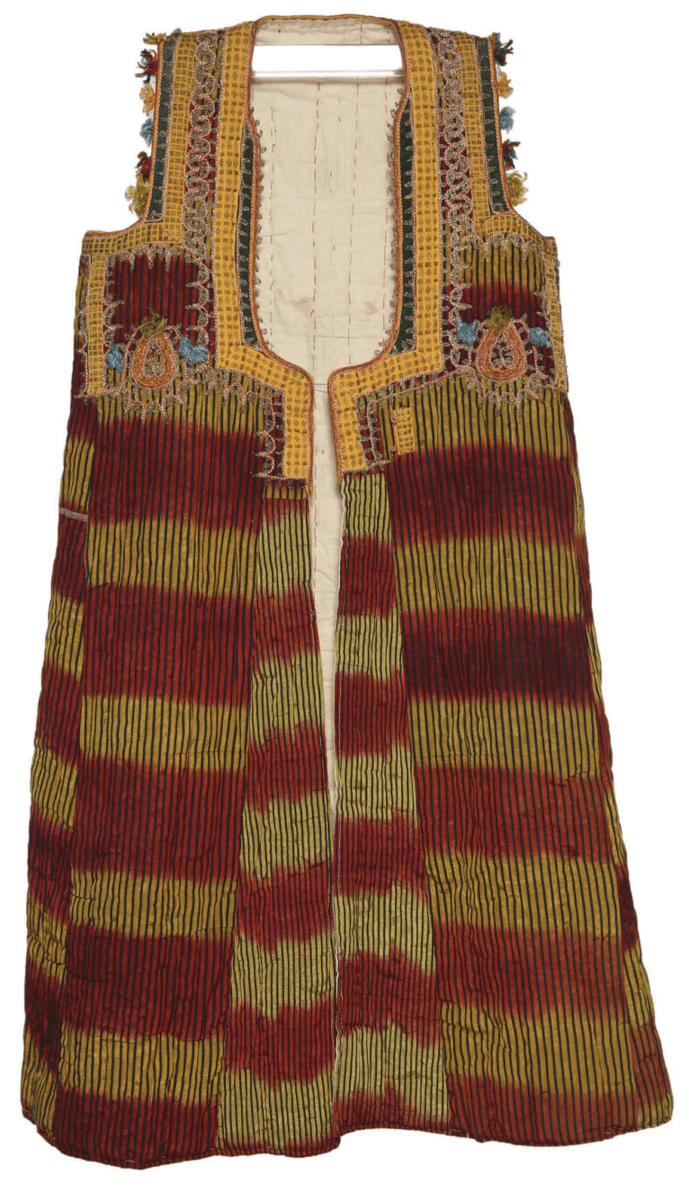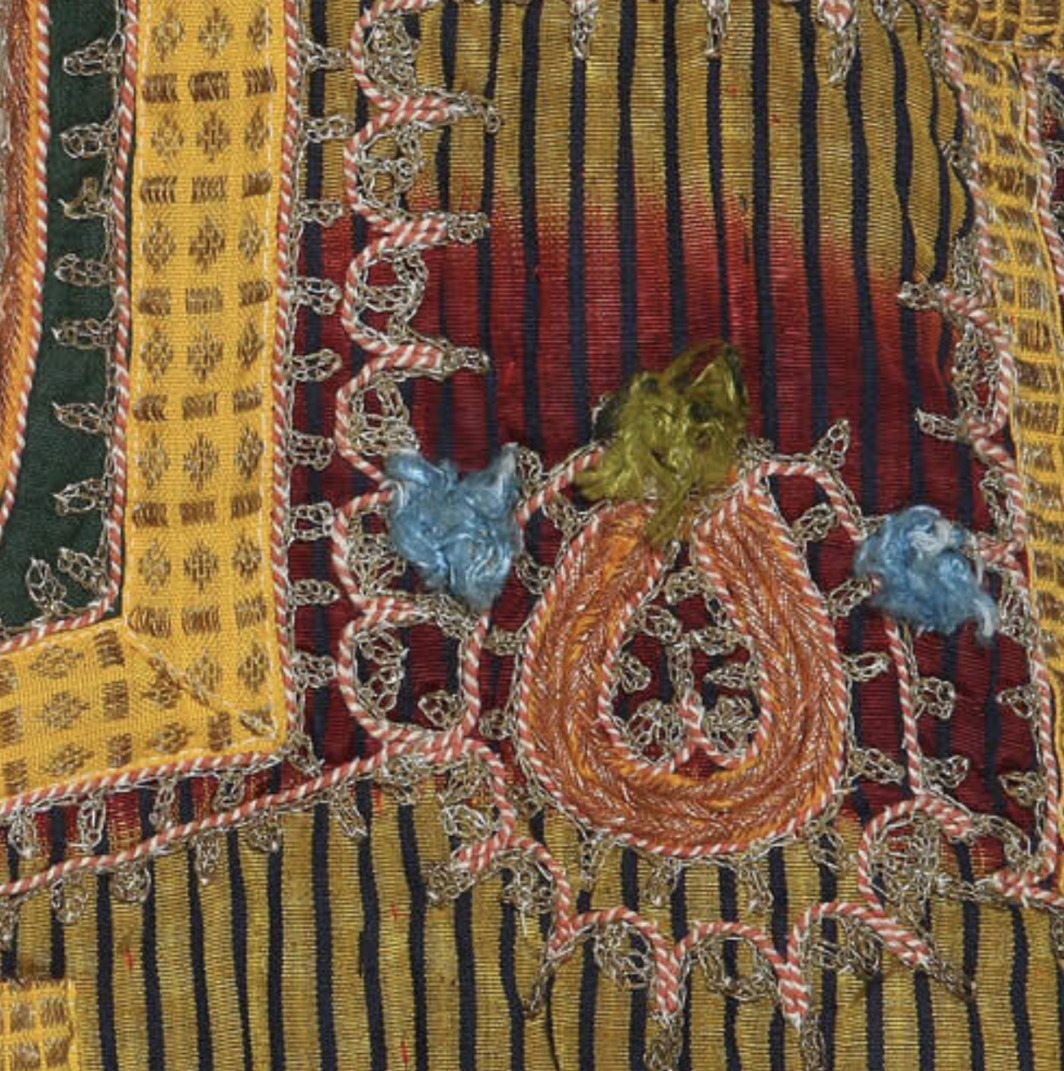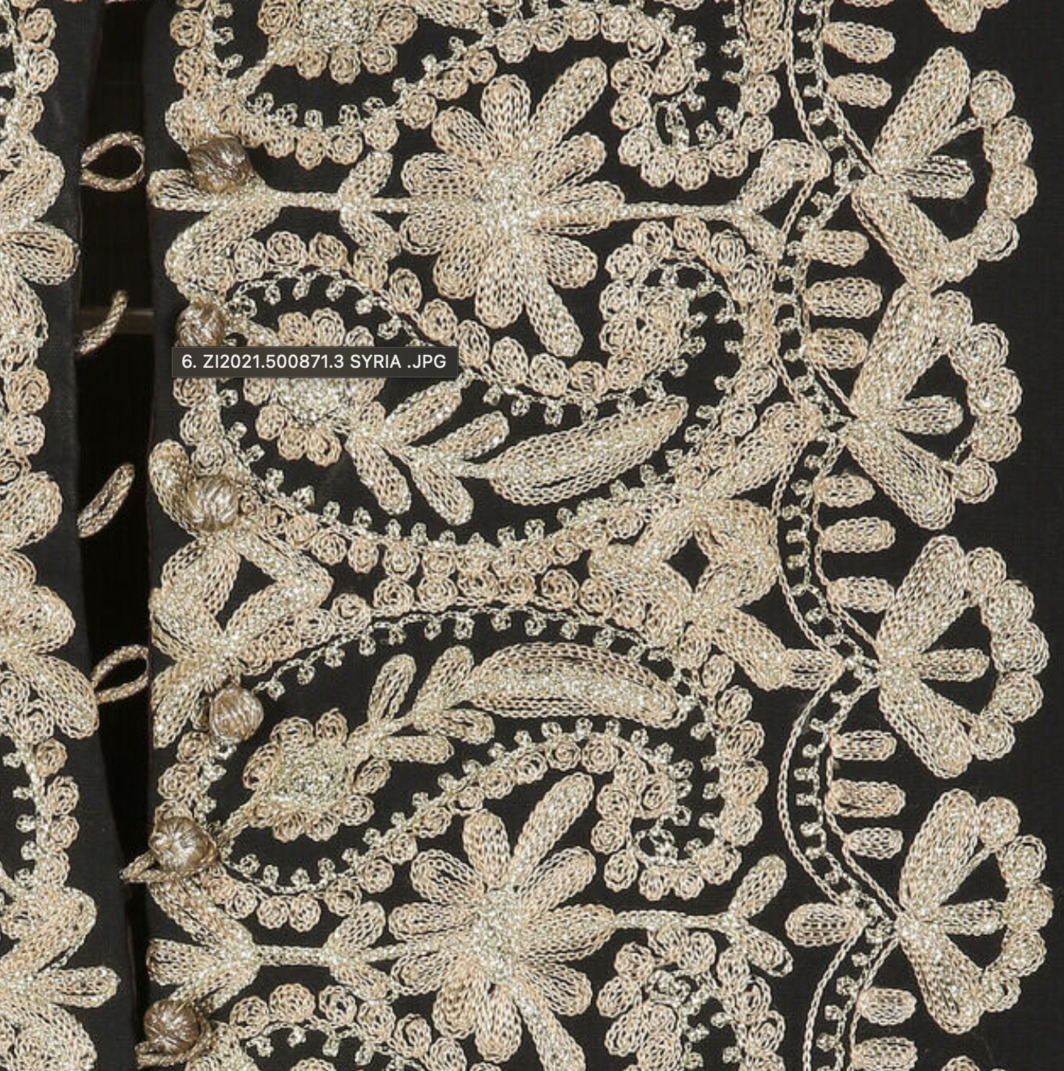A Tangled Web of Metal Part 2
Until now, our exploration has delved deeply into the metal thread embroidery techniques of talli and sarma, also known as dival, and their various terms along with potential etymological origins. However, as talli and sarma showcase influences from neighbouring cultures, our attention will now shift to metal thread embroidery techniques exclusive to the Arab world, rooted in global practices.
In this segment, we’ll delve into the intricacies of ‘ghabani’ or ‘aghabani’, ’shugl al tail’ and ‘taḥrīry’. While the former boasts uniqueness in Syria, particularly in Aleppo and Damascus, the latter finds its origins in Bethlehem, Palestine.
Chain Stitch with a Twist – Ghabani
Ghabani embroidery, originating from Syria, showcases a unique form of chain stitch work executed with primarily metal threads with a hook. The term “ghabani” refers not only to the embroidery technique but also to the final product adorned with this distinctive craftsmanship. In the 19th and 20th centuries, Aleppo and Damascus were significant hubs for ghabani production in the Arab world.
A ‘’ghabani’ embellished sleeveless jacket, Aleppo, Syria c. early 20th century; Acc No: ZI2019.500497 SYRIA; Source: The Zay Initiative collection, Link
Closeup of a ‘’ghabani’ embellished sleeveless jacket, Aleppo, Syria c. early 20th century; Acc No: ZI2019.500497 SYRIA; Source: The Zay Initiative collection, Link
The technique involved a specific type of embroidered fabric, commonly silk or cotton, with Damascus and Aleppo serving as prominent centres for this craft exporting ghabani fabrics all across the Arab world. However, while Aleppo and Damascus were renowned for its ghabani textiles, there was also a significant influx of ghabani fabrics from India through Iran to meet the soaring demand.
Ghabani embroidery, embellished a variety of objects, including covers, curtains, tablecloths, as well as men’s clothing like coats, sashes, and turbans. It even found its place in the early 20th-century wedding dresses for women in the Jerusalem region of Palestine. Interestingly, Jerusalem, despite being a major city, did not develop its own embroidery style. This phenomenon can be attributed to the city’s international vibrancy, constantly exposed to diverse foreign influences brought in by people from around the world with their distinct regional costumes. Dresses in the Jerusalem area primarily featured fabrics imported from Damascus, notably Damascene striped silk, and ghabani textiles.
Many assert that the ghabani traces its roots to the Ottoman era in Damascus, a time when bespoke embroidered fabric was exclusively crafted for men of esteemed religious stature or high social standing. Interestingly, it was the women who pioneered this intricate craft, learning the art of embroidery from their mothers or aunts during their formative years. In the period preceding the civil war in Syria, approximately 5000 women in Duma, Damascus, were engaged in ghabani production, working from the confines of their homes due to their conservative backgrounds.
These women, despite facing challenges posed by the conservative setting, diligently practiced their craft. The outbreak of the civil war in 2011 disrupted this longstanding tradition, and the unique method of ghabani embroidery, carried out by these women, became a lost art. As they fled their homes and took refuge in camps in foreign lands during the turmoil, these women continued honing their skills, ensuring the survival and revival of the nearly extinct craft. Today, their collective efforts and passion for the craft have breathed new life into ghabani, preserving it for future generations.
A ‘’ghabani’ embellished tunic dress, Syria c. early 20th century; Acc No: ZI2021.500871.3 SYRIA; Source: The Zay Initiative collection, Link
Closeup of a ‘’ghabani’ embellished tunic dress, Syria c. early 20th century; Acc No: ZI2021.500871.3 SYRIA; Source: The Zay Initiative collection, Link
Couching with Cord – Taḥrīry
Bethlehem, Palestine, renowned for its Biblical significance and the ingrained art of cross stitching in Palestinian culture, also holds a distinct prowess in the metal thread embroidery technique of couching. In the 19th century, Bethlehem emerged as a focal point of Palestinian fashion, particularly excelling in the couching technique. Collaborating with the nearby Beit Jala area, Bethlehem elevated couching to an art form, establishing its uniqueness within the existing technique. This specific couching technique is referred to as taḥrīry.
Taḥrīry embroidery stands out as the predominant form in Bethlehem’s rich embroidery tradition, surpassing the traditional Palestinian cross stitch in prevalence. Widely employed on chest panels adorned instead of cross stitch patterns, it gained notable popularity in the 20th century, notably featured on Bethlehem’s unique jackets known as taksiry.
Characterized by intricate cord couching, taḥrīry showcases thin cords in diverse colours, often incorporating a metallic thread. These cords, sewn down with silk, form sinuous and stylized floral patterns, resembling passementerie. In taḥrīry, unlike other couching techniques, the primary design emerges from cords or braids, frequently made of metallic threads. While silk braids are not uncommon, the distinctive use of metal threads sets taḥrīry apart from the typical cross stitched thobe dresses of the region.
Reflecting the influence of regional flora and fauna, taḥrīry’s uniqueness extends beyond motif depiction to the playful exploration of negative spaces between cords and embroidery, adding a distinctive charm to its artistic expression.
Simple Stitches with Metal – Shughl al tail
Syria’s influence in the realm of metal thread embroidery surpasses the production of sarma or dival for the local Arab market under Ottoman rule, much like the contribution made by Palestine. Syria has actively participated in shaping a distinctive metal thread embroidery technique, building upon an existing foundation.
While Damascus and Aleppo served as pivotal centres for sarma, Hama emerged as the specialized hub for a unique Syrian metal thread embroidery technique, concurrently catering to the local market with talli on net.
Hama’s garments were predominantly crafted from cotton gauze, featuring dyed patterns embellished with metal thread embroidery known as ‘shughl al tail.’ This embroidery style treated flat beaten metal threads as conventional threads, employing various standard embroidery techniques such as blanket stitch, satin stitch, overcast stitch, running stitch, and more to enhance the patterns.
Fabrics adorned with shughl al tail gained popularity for creating ceremonial thobes for women, particularly worn during pre-wedding celebrations like henna nights. Additionally, these fabrics were sought after for crafting an array of accessories like bags and pouches, as well as furnishing various household items, including bath towels, wall hangings, curtains, and more.
Conclusion
In conclusion, the rich tapestry of metal thread embroidery across the Arab world reflects a fascinating fusion of cultural influences and regional specialties. From the Ottoman-inspired sarma and dival found in the bustling markets of Damascus and Aleppo to the diversity of talli spanning from the Arabian Peninsula to Egypt and the Levant, each technique tells a story of craftsmanship deeply rooted in local traditions. While the intricate taḥrīry embroidery from Bethlehem adds a unique touch to Palestinian attire, showcasing the diverse artistic expressions within the region the distinctiveness of kalabdun in Iraq emphasizes the regional nuances within the broader Pan-Arab tradition.
The survival and revival of these embroidery techniques, despite the challenges brought by time and conflicts, stand as a testament to the resilience and dedication of skilled artisans. As we unravel the threads of history woven into these embellished fabrics, we gain a deeper appreciation for the artistry that transcends borders and connects generations through the language of stitches and patterns.
| Bibliography |
|




